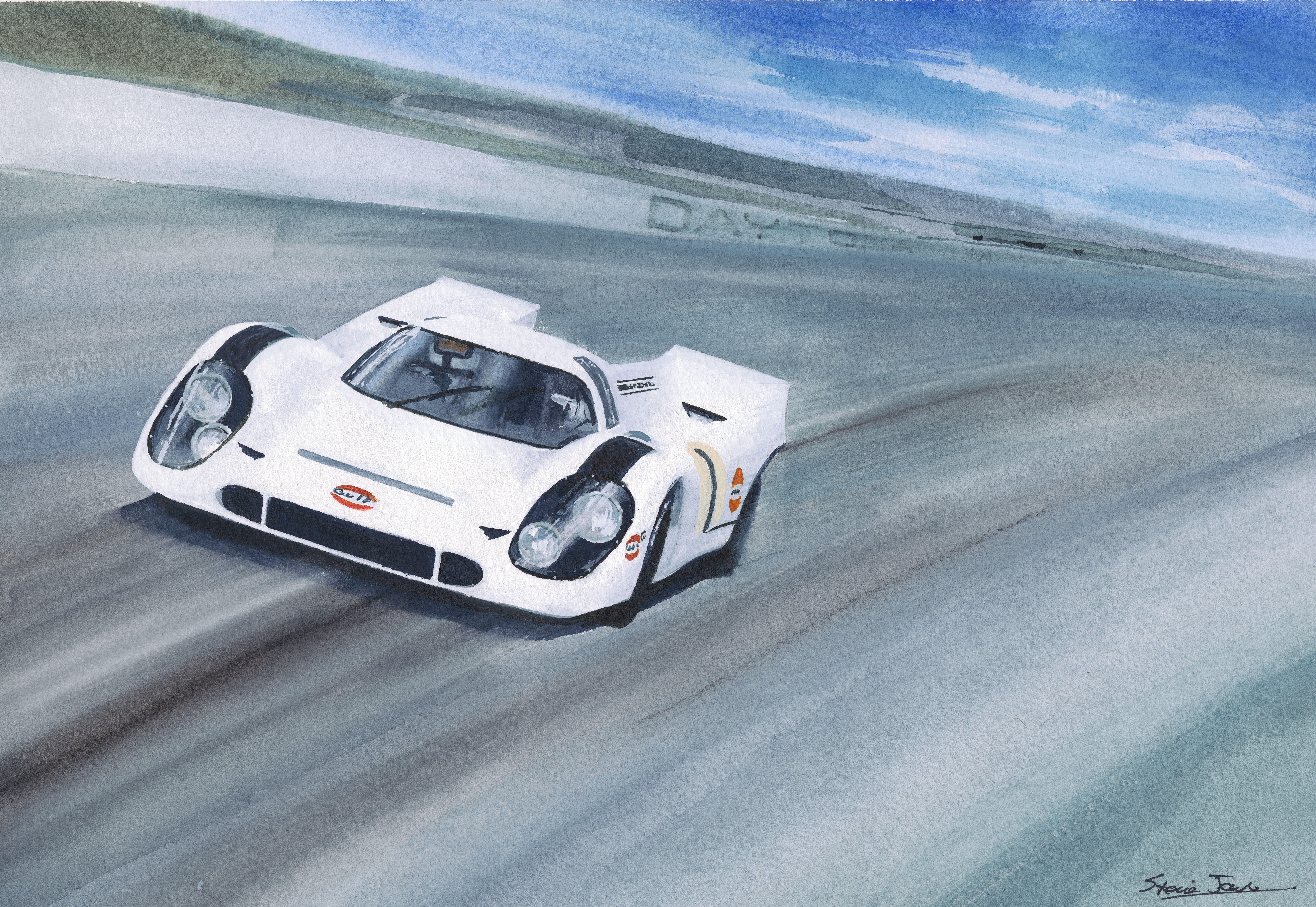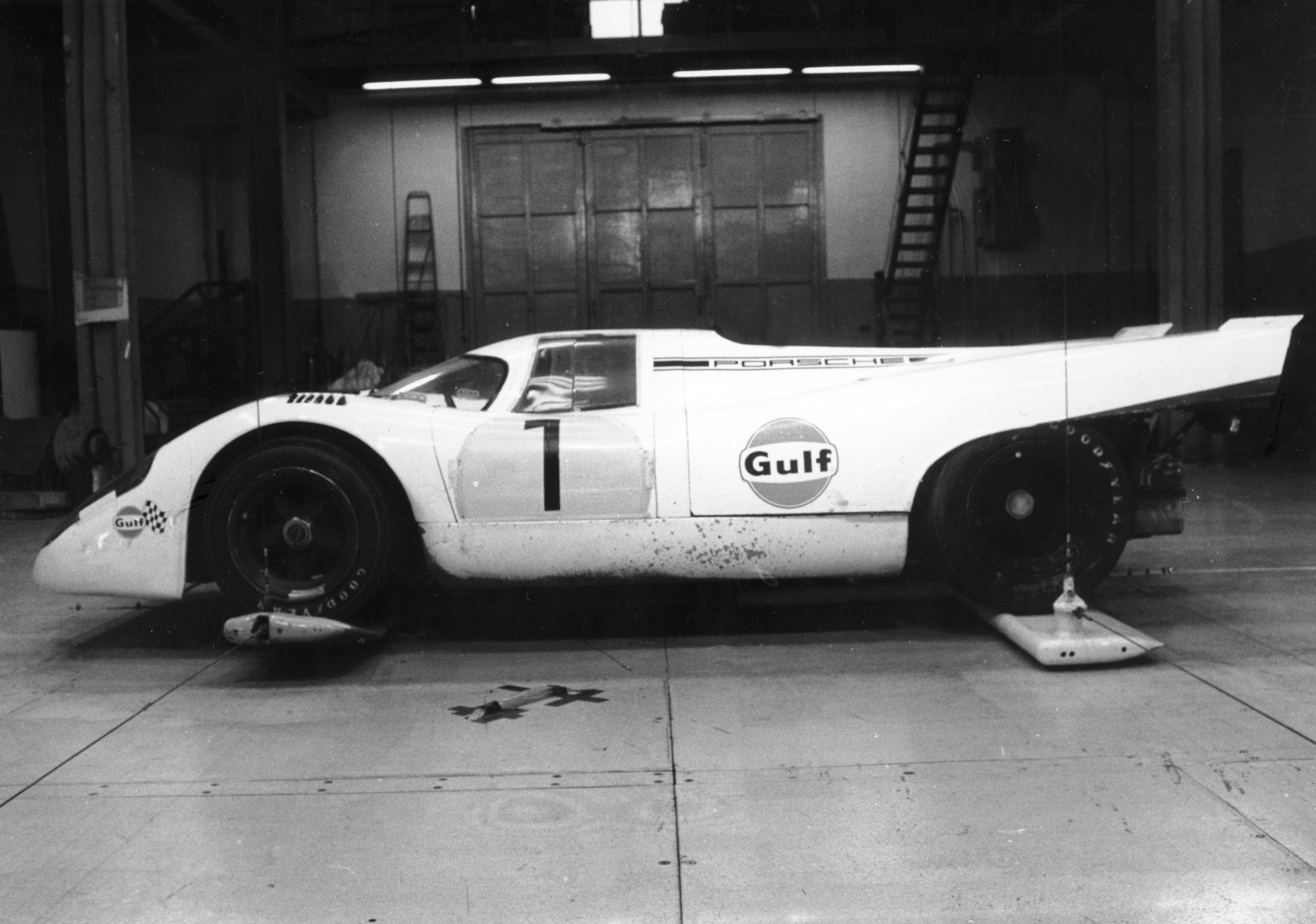Porsche was pretty good at keeping secrets. Before the 917 was shown at the Geneva Salon in March of 1969, even the factory’s team drivers were unaware of its existence. Porsche had designed and built the first car in near-complete secrecy over the previous eight months. Once the car began testing and appearing at races, it was obviously fast. Jo Siffert put a 917 on the pole at its first race, the 1000 KM at Spa, but tellingly elected not to race it. Siffert and Brian Redman went on to win the race in a longtail 908. By June, at the 24 Hours of Le Mans, it was no secret that the 917 had a serious handling problem. At high speed on the Mulsanne straight, it was wandering across the road. The high-speed bends were equally difficult. But in the race, Vic Elford and Richard Attwood employed some judicious driving to hold the lead for about 18 hours. They might have won had the transmission case not cracked allowing oil to flood the clutch.
Despite a continuing issue with instability, Siffert and Kurt Ahrens managed to take the first victory for a 917 at the final race of the Manufacturer’s Championship season. In the Zeltweg 1000 KM race in August, the 3.0-liter Cosworth-powered M3 Mirage was faster than the 917, but Porsche reliability and hard-driving prevailed. Two months later, Porsche returned to the Osterreichring at Zeltweg for a test session, determined to resolve the evil handling characteristics of the 917 once and for all. Meanwhile, Porsche had contracted with John Wyer’s Gulf-sponsored JW Automotive Engineering team to run the official factory cars in the 1970 Championship. The Zeltweg test would be the first with Porsche and JWAE personnel working together. While the Porsche engineers, Peter Falk and Helmut Flegl, concentrated on trying numerous shock absorber and spring settings (to no avail), Gulf team Chief Engineer, John Horsman, famously noted the lack of dead bugs on the tail surfaces of the test cars.
Jo Siffert takes the checkered flag at Zeltweg, August 1969 – Porsche Archive
The little gnats led Horsman to suspect the real problem was aerodynamic – lack of downforce over the rear wheels. In an inspired bit of shade-tree engineering, he worked with his mechanics, Ermanno Cuoghi and Peter Davies, to reshape the tail of the 917. Using sheet metal, tape, and screws, they extended the line of the tail from the top of the rear wheel arches to the top of the tail fins (already running nearly straight up). Finished overnight, the new tail was first tried by a skeptical Brian Redman on the following morning. Instead of coming in after the customary two laps with a grim shake of the head, Redman stayed out for seven progressively better laps. Returning to the pits, Redman stated simply and prophetically, “Now it’s a racing car……”
View of modified 917 tail, Zeltweg test, October 1969 – John Horsman Collection
By the end of the Zeltweg test, the 917 was fully five seconds faster per lap than it had been three days before. Even Ferdinand Piech, as head of R&D for Porsche and doggedly committed to minimizing drag on his race cars, had to approve of a new tail design. However, there was a huge amount of work to be done. The Porsche design team, led by Eugen Kolb, had to finalize the new tail shape and this included redesigning the rear window, creating a ‘tunnel’ in the upward sweeping tail for rear vision, and re-routing the exhaust pipes to the now-open area behind the rear wheels (the 917 originally had side exhaust outlets for the forward cylinders of the flat 12). This required new side pods as well. The new nose shape had to be finalized, including larger ducts and fender vents to improve brake cooling. All of this work was accomplished in a mere four weeks as there was another important test scheduled. The new version of the 917, now commonly referred to as the 917K, was scheduled to test at Daytona on November 19 and 20, 1969.
This test was kept highly secret and no photos were taken. Even Speedway employees were kept out of the grandstands and the infield. Attendees included Ferdinand Piech, Helmut Flegl, Peter Falk and Helmuth Bott plus a group of mechanics from Porsche. The Gulf team was represented by John Wyer, John Horsman, team manager David Yorke, mechanics Alan Hearn and Ermanno Cuoghi. Test drivers were Jo Siffert, Kurt Ahrens, Pedro Rodriguez, and David Hobbs. Pedro Rodriguez had signed to drive for JWAE and would have his first chance at the 917 during this test. David Hobbs was on hand as a tryout, potentially to co-drive with Pedro.
Artist conception of November 1969 Daytona test by Steve Jones – Steve Jones Scan 1 painting for “Gulf 917”
This was the first chance to test the finished version of the new tail at high speed, along with the other detail revisions (new nose shape, engine exhaust, rearview tunnel, etc.). Porsche also brought a long tail for testing but the drivers were not enthusiastic compared to the new ‘K’ tail. The activities combined specific testing, including tire comparison between Goodyear and Firestone, with simulated races or endurance runs. Testing was hampered by several on-track incidents. Ahrens had a tire failure that damaged chassis 012, requiring significant repairs. There is mention in sources such as Karl Ludvigsen’s Excellence Was Expected that Rodriguez was hit by a wind gust, causing a crash on the banking. However, John Horsman and Alan Hearn could not recall this incident specifically when consulted for my book, Gulf 917, and it is not mentioned in Walter Naher’s 917 Archiv.
On the second day, Hobbs missed a gear coming out of the infield and on to the banking. Finding second gear instead of fourth on the upshift over-revved the engine. In the glare of this intense test session with the Porsche personnel, the mistake likely cost Hobbs the job of partnering with Rodriguez for 1970. Porsche had already specified that Siffert and Redman would be the ‘factory’ drivers in one Gulf car (those drivers to be paid by Porsche). JWAE would have the choice of drivers for the other car (to be paid by Gulf). John Wyer had hoped to form what hindsight says could have been a ‘dream team’, pairing Pedro Rodriguez with Jacky Ickx. Ickx had played a prominent part in JWAE’s success from 1967 through 1969. To Wyer’s chagrin, Ickx signed with Ferrari for both Formula One and sports car racing in 1970. Wyer opined in The Certain Sound: “Probably one of his greatest mistakes.” This left the job to the relatively unknown Leo Kinnunen from Finland to co-drive with Rodriguez.
The Daytona testing led to a number of design and detail changes that would be incorporated into the race cars for the 1970 season. Cockpit heat issues led the JWAE team to reroute oil to the cooler through dedicated oil lines rather than using chassis tubes as originally designed. Dedicated oil lines also seemed safer than relying on chassis tubes to conduct the oil. Taper wear on brake pads was a concern as was general stability under braking. This led Porsche to rethink the design of the front wheel hub carrier. The test also resulted in several detail changes to the steering rack and the transmission. Rodriguez requested the steering wheel to be closer, so JWAE fabricated a 19mm spacer to be used in the 1970 races. Forward vision on the banking became a concern for the drivers and this led to the development of the D-shape roof window to help with this problem. Best lap times at the Daytona test were in the 1:47 range, about five seconds faster than the existing track record. Complete details of the Daytona test and follow-up work were published in Walter Naher’s book, 917 Archiv.
Although no photos exist of the Daytona test, we do know what the cars looked like when run in Florida. Upon their return from Florida, one of the cars (Chassis 011) was used for wind tunnel testing at the University of Stuttgart facility. There had not been time to check the new nose and tail prior to the Daytona test. However, the December 1969 wind tunnel review confirmed acceptable drag and downforce readings. The increase in aerodynamic drag resulting from the new ‘K’ tail was partly offset by the reduced weight of the rear bodywork. No further changes were made to the body shape prior to the 1970 Daytona race except for the addition of the roof window.
Chassis 011 in the wind tunnel after returning from Daytona, December 1969 – Porsche Archive
The Daytona testing largely finalized the form and specifications for the 917 that JW Automotive would start with for the 1970 racing season. How well did it start? The Gulf-Porsches would finish first and second in the 24 Hours of Daytona with the winning car setting a distance record that stood until 1987. Given the level of documentation throughout the 917 program, it remains surprising that no photo exists of the truly secret Daytona test.







Jay, excellent. Really enjoyed the background story! One slight correction for you, might be a typo, don’t know. The distance record for the Daytona 24 was broken in 1982 by John Paul Sr, John Paul Jr, and Rolf Stommelen, in a Porsche 935. They covered 719 laps of a 3.84 mile circuit. While the 917 covered a few more laps in 1970, the circuit was slightly shorter at 3.81 miles per lap. The Holbert 962 in 1987 again covered more laps, but by then the circuit had shrunk to 3.56 miles, so it was not a record. As far as… Read more »
Thanks Martin, My mistake – I must have looked at laps rather than mileage when working on my book. – Jay G.
Jay, from a driver’s viewpoint, this story really strikes a chord. In my career, including time as a Porsche Werksfahrer, there have been several occasions where the car had an obvious issue, but the crew chief and/or engineers did not believe it, coming from the driver. This is still common today, in my experience. I can really relate to those early 917 pilots and the “grim shake of the head.” Of course, my favorite engineers and teams are the ones that listened and used my feedback as part of developing the chassis. And further, of course, those were often the… Read more »
Hello Randy, Glad you enjoyed it. I have been fortunate to hear Brian Redman and John Horsman talk about the famous Zeltweg test in person on a few occasions. An interesting footnote to the 917 story that is not often discussed is the variability of development ‘feel’ and set up skills across the drivers. This may have affected how the engineers interpreted feedback at times. Your comments are interesting in that your career falls into an era where aerodynamics for race cars are/were much better understood, in theory, than they were in 1969.
Being from German ancestry I am allowed to say ”thick headed” comes to mind
Nice, “compact” review citing great sources! On another site I was berated for referring to the engine as a “flat 12”…the most common description in a variety of books, etc. In “non-engineering” terms, what is the correct / preferred designation?
Thank you!
Hello Bob, This is pretty much an endless argument, however, I believe Herr Mezger, the designer of the engine, referred to it as a 180-degree V12. That was my choice for my book – “Gulf 917”. It is important to note that unlike most other ‘flat’ Porsche engines, the 917’s cylinders do not ‘box’. Opposing cylinders move in the same direction in the 917 engine, hence the reference to ‘V’ engines. I also think that ‘Flat 12’ is perfectly fine shorthand when we aren’t getting too technical.
The statement that “Jo Siffert put a 917 on the pole at its first race, the 1000 KM at Spa,” is up for discussion as I attended the 1969 Nurburgring 1000 km race in May where a 917 was entered. I never saw it run, but rumors abounded regarding that when it was practicing, it didn’t handle too well. See this for reference: https://www.racingsportscars.com/entry/Nurburgring-1969-06-01.html It was entered as car number 61. Two more 917s were entered but did not show up on the grid.
Hello Rick, There are numerous book and period magazine sources for this information, plus I have discussed the Spa race with Brian Redman directly on a few occasions. One 917 did start at Spa (Mitter blew the engine on lap 1). Your link is referencing the later Nurburgring race where the 917 (Chassis 004) did race and finished 8th (first win for a 917).
I should have said first race -finish- for a 917, at the Nurburgring in 1969.
My bad. I didn’t realize that the Spa, 1969 race was in May and the Nurburgring race was in June., 1969. The previous two 1000 km races at the Nurburgring (1967 & 1968) occurred in May. I just assumed that Spa was later in the year. I stand corrected.
[…] to be done. The story goes that the car had gnats all over its front and midsection, but none on the tail. This led them to believe there is a problem with downforce on the rear of the car. […]